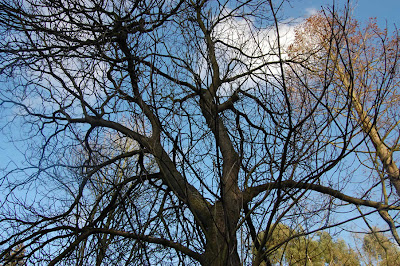As I mentioned in the last post on this topic, the trees around the Bowling Green proved a little tricky. The first of these mentioned in the booklet were two very old Black Mulberries (Morus nigra) by the bowler's hut. So we went and searched.
I think we were flummoxed. We just weren't sure without the leaves. But these may be they:
However wrong or right we were about the mulberries, the next was easy - a group of blue-leaved Atlas cedars (Cedrus atlantica 'glauca'). Cedars, and blue leaved, not hard to spot.
But then we hit a real hitch - the next tree we were directed to was the nearby Horse Chestnut (Aesculus hippocastanum). Easy you might think
Except there wasn't one there. Or anywhere near. After a lot of searching and several reviews of the map we spotted this:
The site of an ex-Horse Chestnut? Just how old was this Trail? The little yellow booklet had no date on it, but the contact phone number began 071.
OK. The fount of all arcane knowledge Wikipedia tells us that '071' came into use as the prefix for Inner London in May 1990, and changed again to '0171' on 'phONE day' (16 April 1995) - 0207 only arrived in April 2000. Which means that the Tree Trail Guide must have been written between 1990 and 1995 - at least 15 years ago. We may well have a copy that was still being produced a little later than that (they probably didn't bother to change the phone number straight away), but it means that the document is probably at leasst 12-13 years old.
So trees may be missing. They may have fallen or been felled. A new challenge. And that little patch of disturbed earth, next to a newly-planted tree, probably marks where the Horse Chestnut once stood.
After the sad Horse Chestnut site, the Trail led us to a collection of trees, all quite close together on the map. A Sweetgum, (Liquidamber styraciflua), a (Red) Indian Bean tree (Catalpa bignonioides), a purple-leaved (sic) Norway maple (Acer platanoides, 'Goldsworth Purple'), a Dawn Redwood (Metasequoia glyptostroboides) and a Box Elder (Acer negundo). But which was which? This is what we could see:-
and we wandered amongst them getting quite confused until help arrived in the sign of, well, a sign:
So that was the (Red) Indian Bean.
Which probably made this the maple:
and this was clearly the tall Redwood:
So this was therefore the box elder - possibly:
,,, and the sweetgum must be the small tree on the far right of the earlier group shot.
By that stage I felt like I was playing one of those TV quizzes where you have to get five objects into five holes and hit a button - after which the host tells you what an idiot you've made of yourself. Even if we identified them properly at the time, I'm sure I may have the photos in the wrong order!
But finally, an easy spot came along. Two eucalyptus trees (Eucalyptus gunii).
The Trail next guided us to look at the Wisteria (Wisteria sinensis) along the outside of the Sexby gardens.
This we did with reservation, because we don't think it counts as a tree! There is one real tree inside the gardens, a Ginko tree (Ginkgo biloba):
And then we were on a run. Two huge London Planes (Platanus hispanica),
a Weeping Willow (Salix chrysocoma) by the lake
and a group of Yew (Taxus baccata)
Straightforward.
The next tree on the Trail was meant to be a White Willow (Salix alba) - but it was nowhere to be seen. Not another missing tree? We felt in need of sustenance before unravelling another conundrum, so we kind of gave up and headed off to the new cafe (the old one indicated on the Trail map was demolished years ago).
The cafe was warm inside and we lingered over coffees. In the distance was the horrible, growing, Tolkienesque Shard.
We felt exposed, and wanted to be indoors, away from the all-seeing Eye.
So we went home.


















No comments:
Post a Comment